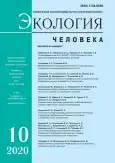SEASONAL VARIATIONS IN WORKING CAPACITY AND SERUM LACTATE CONCENTRATION IN LABORATORY RATS
- Authors: Zamoshchina T.A.1,2,3, Gostyukhina A.A.1, Zaitsev K.V.1, Zhukova O.B.1, Svetlik M.V.2,3, Abdulkina N.G.1, Prokopova A.V.1,3
-
Affiliations:
- Siberian Federal Scientific and Clinical Center of the Federal Medical and Biological Agency
- Siberian State Medical University
- National Research Tomsk State University
- Issue: Vol 27, No 10 (2020)
- Pages: 17-22
- Section: Articles
- URL: https://journals.rcsi.science/1728-0869/article/view/47145
- DOI: https://doi.org/10.33396/1728-0869-2020-10-17-22
- ID: 47145
Cite item
Full Text
Abstract
Keywords
Full Text
##article.viewOnOriginalSite##About the authors
T. A. Zamoshchina
Siberian Federal Scientific and Clinical Center of the Federal Medical and Biological Agency; Siberian State Medical University; National Research Tomsk State University
A. A. Gostyukhina
Siberian Federal Scientific and Clinical Center of the Federal Medical and Biological Agency
Email: exper@med.tomsk.ru
кандидат биологических наук, научный сотрудник экспериментальной лаборатории биомедицинских технологий
K. V. Zaitsev
Siberian Federal Scientific and Clinical Center of the Federal Medical and Biological Agency
O. B. Zhukova
Siberian Federal Scientific and Clinical Center of the Federal Medical and Biological Agency
M. V. Svetlik
Siberian State Medical University; National Research Tomsk State University
N. G. Abdulkina
Siberian Federal Scientific and Clinical Center of the Federal Medical and Biological Agency
A. V. Prokopova
Siberian Federal Scientific and Clinical Center of the Federal Medical and Biological Agency; National Research Tomsk State University
References
- Агаджанян Н. А. Исследование влияния экстремальных видов туризма и спорта на функциональное состояние кардиореспираторной системы // Материалы XI Международного симпозиума «Эколого-физиологические проблемы адаптации», Москва, 27-28 января, 2003. 224 с.
- Агаджанян Н. А. Экологическая физиология: проблема адаптации и стратегия выживания // Материалы X Международного симпозиума «Эколого-физиологические проблемы адаптации», Москва, 2001. С. 5-12.
- Волчегорский И. А., Долгушин И. И., Колесников О. Л., Цейликман В. Э. Экспериментальное моделирование и лабораторная оценка адаптивных реакций организма. Челябинск: ЧГПУ, 2000. С. 27-32.
- Гостюхина А. А., Зайцев К. В., Замощина Т. А., Жукова О. Б., Светлик М. В. Абдулкина Н. Г. Сезонные особенности содержания кортикостерона в сыворотке крови крыс после физического переутомления в условиях светового десинхроноза // Российский физиологический журнал имени И. М. Сеченова. 2016. № 102 (1). С. 50-55.
- Гостюхина А. А., Замощина Т. А., Зайцев К. В. Гутор С. С., Жукова О. Б., Светлик М. В., Абдулкина Н. Г., Зайцев А. А. Адаптивные реакции крыс после световых десинхронозов и физического переутомления // Бюллютень сибирской медицины. 2018. № 17 (3). С. 22-34.
- Долгова В. В., Меньшикова В. В. Клиническая лабораторная диагностика: национальное руководство. М.: ГЭОТАР-Медиа, 2012. 808 с.
- Житенева Л. Д., Макаров Э. В., Рудницкая О. А. Эволюция крови. Ростов-на-Дону: АзНИИРХ, 2001. 114 с.
- Зайцева М. С., Иванов Д. Г., Александровская Н. В. Работоспособность крыс в тесте «Вынужденное плавание с грузом» и причины ее вариабельности // Биомедицина. 2015. № 4. C. 19-23.
- Медик В. А. Статистика в медицине и биологии. М.: Медицина, 2000. 412 с.
- Меерсон Ф. З., Пшенникова М. Г. Адаптация к стрессорным ситуациям и физическим нагрузкам. М.: Медицина, 1988. 256 с.
- Моссе И. Б. Генетика спорта: вчера, сегодня, завтра // Труды Белорусского государственного университета. 2012. Т. 7, ч. 1. С. 56-68.
- Мякинченко Е. Б., Селуянов В. Н. Развитие локальной мышечной выносливости в циклических видах спорта. М.: ТВТ Дивизион, 2005. С. 338.
- Пат. 2617206 Российская Федерация, МПК G09В 23/28 (2006/01 ). Способ моделирования физического переутомления у крыс в условиях десинхронозов / Гостюхина А. А., Зайцев К. В., Замощина Т. А., Светлик М. В., Жукова О. Б., Абдулкина Н. Г., Зайцев А. А., Воробьев В. А. № 2015133700; заяв. 1 1.08.2015; опубл. 21.04.2017 бюл. № 12. 7 с.
- Роженцов В. В., Полевщиков М. М. Утомление при занятиях физической культурой и спортом: проблемы, методы исследования. М.: Советский спорт, 2006. С. 280.
- РФ ГОСТ Р-53434-2009 Принципы надлежащей лабораторной практики. М.: Стандартинформ, 2009. С. 17.
- Селье Г. Стресс без дистресса. М.: Прогресс, 1982. 128 с.
- Сонькин В. Д. Проблема оценки физической работоспособности // Вестник спортивной науки. 2010. № 3. С. 37-42.
- Brancaccio P., Lippi G., Mffulli N. Biochemical markers of muscular damage // Clin. Chem. Lab. Med., 2010. Vol. 48 (6). P. 757-767.
- Geir S., Robstad B., Skjnsberg O. H., Borchsenius F. Respiratory gas exchange indices for estimating the threshold // Journal of Sports Science and Medicine, 2005. Vol. 4. P. 29-36.
- Nicolaidis M. J., Jamurtas A. Z., Paschalis V. The effect of muscle-damaging exercise on blood and skeletal muscle oxidative stress: magnitude and time-course considerations // Sports Med., 2008. Vol. 38 (7). P 579-606.
Supplementary files







